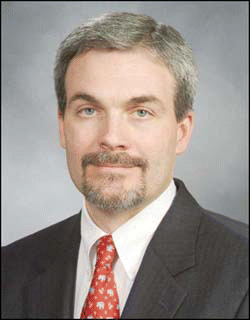One of the enjoyable aspects of our specialty is the variety of patients and problems we see every day. Another stimulating part of our practice is the many areas where we consult and collaborate with a variety of other specialists that also treat head and neck problems. While consultation is an everyday part of contemporary medicine, otolaryngologists-head and neck surgeons might be unique in the number of specialties and territories that we overlap with-or bump into.
Explore This Issue
May 2006Looking at it another way, we could wryly note the number of possible turf battles we might need to navigate on any given day. This could be seen as a problem or a challenge, but I think we should see it as an opportunity. In fact, the history and growth of our specialty can be attributed to strong leaders and talented practitioners who seized such opportunities while working alongside other specialists and demonstrating otolaryngology’s good outcomes. Indeed some areas that are part of our everyday practice in 2006 were mainly performed by other specialties in the past.
I believe the way to maintain and extend our specialty’s strength in the future is to work with other specialties, demonstrating our training and expertise. It might be tempting to just move into other areas and begin working in isolation, however that approach could be counterproductive. Keep in mind that one important factor in the growth of our specialty was integration into the mainstream of surgical practice, which was partly inculcated by extending the surgical portion of residency training.
Now that our specialty has taken control over the PGY-1 year of otolaryngology-head and neck surgery residents’ training, we should not take lightly the implications of separating our residents from other surgical specialties in that year.
Benefits of Multispecialty Collaboration
Surgical specialties can help each other: we have learned from other specialties, and they have learned from us. A friendly encounter with technology used in orthopedic surgery-the shaver, also known as the microdebrider-led to welcome advances in tools for endoscopic sinus surgery, with subsequent refinements applicable to other areas including tonsil and adenoid surgery and laryngology. We all know the impact that otologic surgical techniques have had on neurosurgical practice through things like the powered drill, operating microscope, and transmastoid approaches for access to the middle and posterior fossa. In addition to the incorporation of new techniques, collaboration with other surgeons also enhances patient care. For example, consider the obvious benefits of working with plastic and reconstructive surgeons for free tissue transfer and other advanced reconstructive techniques.
 Dr. Stewart, an ENToday Editorial Board member, is Chair of Otorhinolaryngology at Weill Medical College of Cornell University and Otorhinolaryngologist-in-Chief at New York-Presbyterian Hospital/Weill Cornell Medical Center in New York, NY.
Dr. Stewart, an ENToday Editorial Board member, is Chair of Otorhinolaryngology at Weill Medical College of Cornell University and Otorhinolaryngologist-in-Chief at New York-Presbyterian Hospital/Weill Cornell Medical Center in New York, NY.Let’s explore two examples of the power of collaboration: sleep apnea and skull base surgery. Sleep apnea is an increasingly important health issue today, and it’s clear that no one has yet developed the best treatment for this complicated problem. Chances are, if you have sleep apnea and you see a pulmonary- or neurology-trained sleep specialist, you will be prescribed CPAP; an otolaryngologist will recommend a combination of nasal and palatal surgery; a dentist will recommend a dental appliance; and an oral surgeon will advocate mandibular surgery. While there is clearly a role for each treatment option, when applied in isolation using a one size fits all strategy, results are typically disappointing.
Leave a Reply